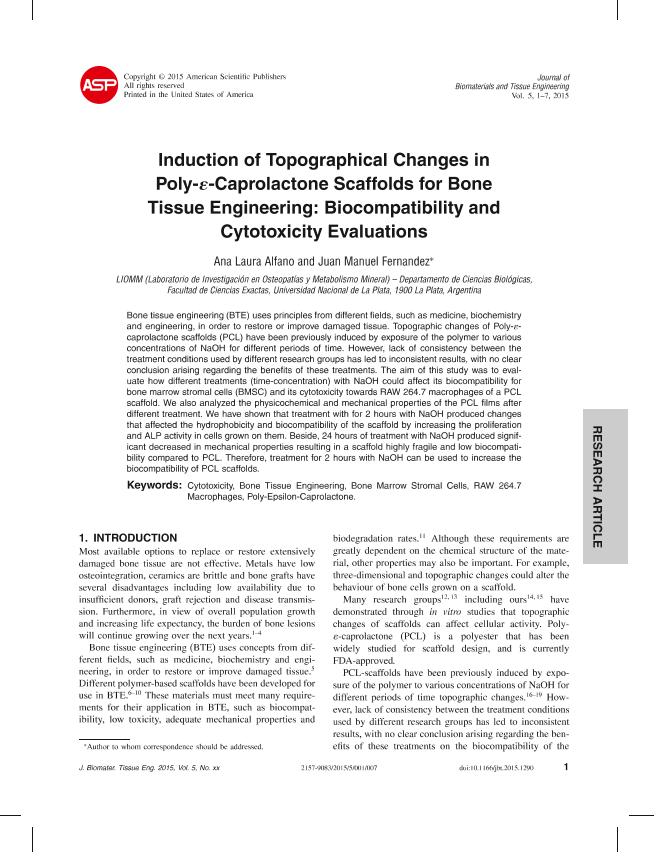Mostrar el registro sencillo del ítem
dc.contributor.author
Fernandez, Juan Manuel

dc.contributor.author
Alfano, Ana Laura
dc.date.available
2017-03-10T21:15:36Z
dc.date.issued
2015-02
dc.identifier.citation
Fernandez, Juan Manuel; Alfano, Ana Laura; Induction of Topographical changes in Poly-ε-Caprolactone scaffolds for bone tissue engineering: biocompatibility and cytotoxicity evaluations; American Scientific Publishers; Journal of Biomaterials and Tissue Engineering; 5; 2; 2-2015; 142-149
dc.identifier.issn
2157-9083
dc.identifier.uri
http://hdl.handle.net/11336/13743
dc.description.abstract
Bone tissue engineering (BTE) uses principles from different fields, such as medicine, biochemistry and engineering, in order to restore or improve damaged tissue. Topographic changes of Poly-ε-caprolactone scaffolds (PCL) have been previously induced by exposure of the polymer to various concentrations of NaOH for different periods of time. However, lack of consistency between the treatment conditions used by different research groups has led to inconsistent results, with no clear conclusion arising regarding the benefits of these treatments. The aim of this study was to evaluate how different treatments (time-concentration) with NaOH could affect its biocompatibility for bone marrow stromal cells (BMSC) and its cytotoxicity towards RAW 264.7 macrophages of a PCL scaffold. We also analyzed the physicochemical and mechanical properties of the PCL films after different treatment. We have shown that treatment with for 2 hours with NaOH produced changes that affected the hydrophobicity and biocompatibility of the scaffold by increasing the proliferation and ALP activity in cells grown on them. Beside, 24 hours of treatment with NaOH produced significant decreased in mechanical properties resulting in a scaffold highly fragile and low biocompatibility compared to PCL. Therefore, treatment for 2 hours with NaOH can be used to increase the biocompatibility of PCL scaffolds.
dc.format
application/pdf
dc.language.iso
eng
dc.publisher
American Scientific Publishers
dc.rights
info:eu-repo/semantics/openAccess
dc.rights.uri
https://creativecommons.org/licenses/by-nc-sa/2.5/ar/
dc.subject
Cytotoxicity
dc.subject
Raw 264.7 Macrophages
dc.subject
Bone Tissue Engineering
dc.subject
Poly-Epsilon-Caprolactone
dc.subject.classification
Textiles

dc.subject.classification
Ingeniería de los Materiales

dc.subject.classification
INGENIERÍAS Y TECNOLOGÍAS

dc.title
Induction of Topographical changes in Poly-ε-Caprolactone scaffolds for bone tissue engineering: biocompatibility and cytotoxicity evaluations
dc.type
info:eu-repo/semantics/article
dc.type
info:ar-repo/semantics/artículo
dc.type
info:eu-repo/semantics/publishedVersion
dc.date.updated
2017-03-08T15:39:57Z
dc.journal.volume
5
dc.journal.number
2
dc.journal.pagination
142-149
dc.journal.pais
Estados Unidos

dc.journal.ciudad
Valencia
dc.description.fil
Fil: Fernandez, Juan Manuel. Universidad Nacional de la Plata. Facultad de Ciencias Exactas. Departamento de Ciencias Biologicas. Laboratorio de Investigacion En Osteospatias y Metabolismo Mineral; Argentina. Consejo Nacional de Investigaciones Científicas y Técnicas; Argentina
dc.description.fil
Fil: Alfano, Ana Laura. Universidad Nacional de la Plata. Facultad de Ciencias Exactas. Departamento de Ciencias Biologicas. Laboratorio de Investigacion En Osteospatias y Metabolismo Mineral; Argentina
dc.journal.title
Journal of Biomaterials and Tissue Engineering
dc.relation.alternativeid
info:eu-repo/semantics/altIdentifier/doi/http://dx.doi.org/10.1166/jbt.2015.1290
dc.relation.alternativeid
info:eu-repo/semantics/altIdentifier/url/http://www.ingentaconnect.com/content/asp/jbte/2015/00000005/00000002/art00009
Archivos asociados
